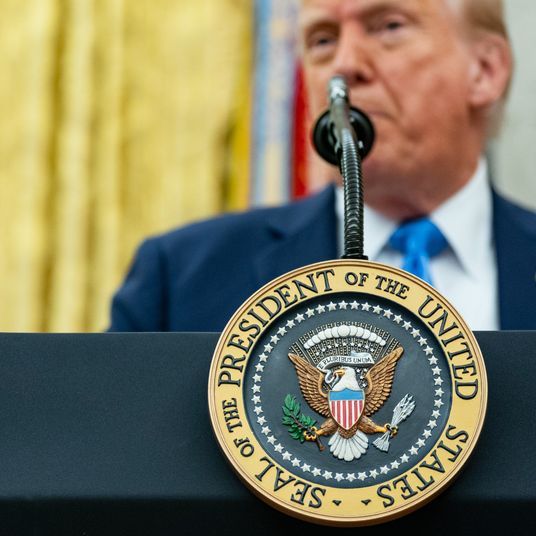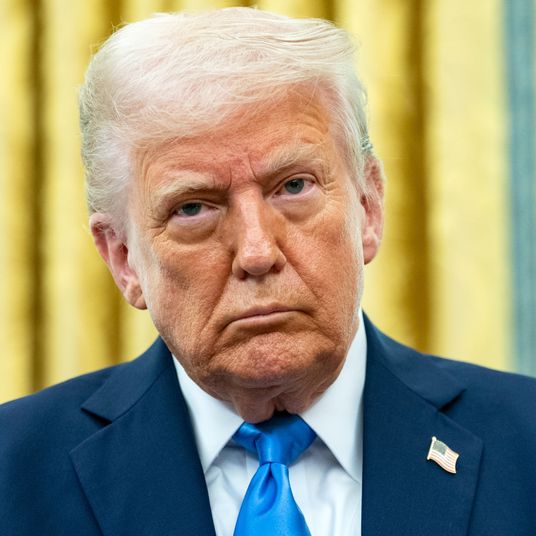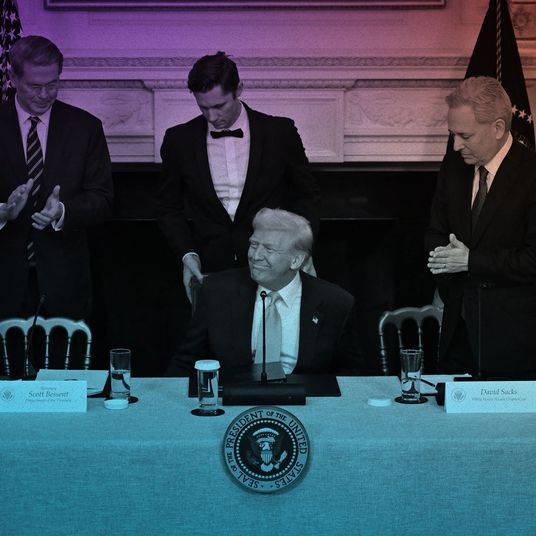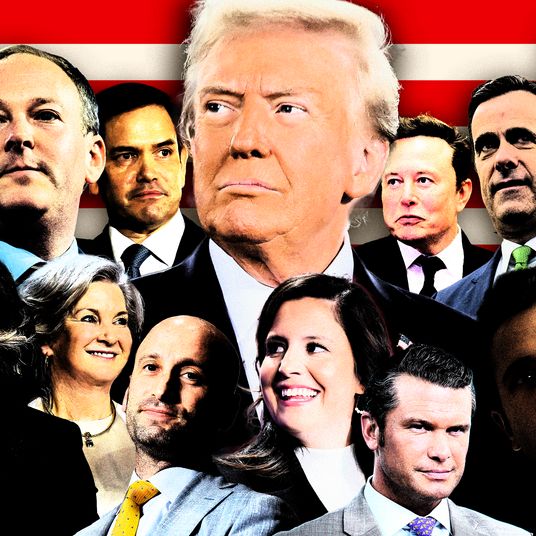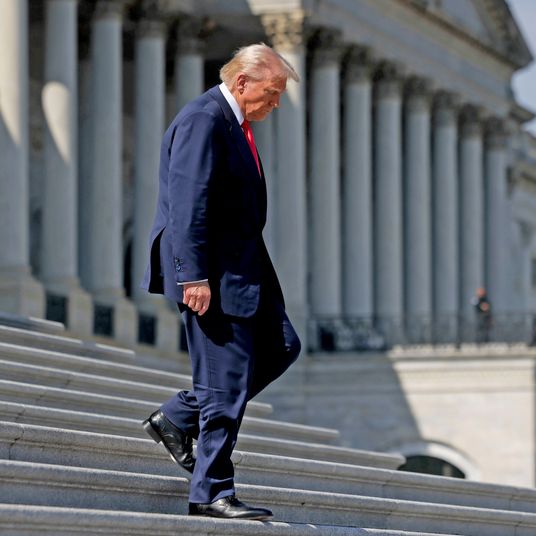
After the debacle over Senate passage of a spending bill earlier this month, it’s abundantly clear that congressional Democrats do not have the power to get in the way of Donald Trump’s aggressive 2025 plans. The administration and its own congressional allies now plan to bundle most of his legislative agenda in a budget-reconciliation bill that cannot be filibustered, meaning that so long as Republicans stick together, Democrats literally do not have the power to stop it. So far, fear of and loyalty to Trump have kept the GOP in harness on key House and Senate votes.
So why are the House and Senate moving so slowly toward enactment of that “one big, beautiful bill” Trump has endorsed? Here’s the problem: The arithmetic of enacting Trump’s tax and spending must-haves without market-terrifying new budget deficits is devilishly difficult, and many small but bright-red devils lurk in the details. The president is famously uninterested in details, so his vague “get it done” injunctions to Republicans on the Hill have not kept them from serious disagreements on those details. The road ahead is long: The House and Senate have passed separate and very different budget resolutions (the blueprint that outlines the numbers and key assumptions behind them) that must be reconciled, and once they are, the House and Senate must pass the same reconciliation bill to send to Trump’s desk.
Here are some of the major issues still dividing them after countless meetings.
.
Should tax cuts be temporary or permanent?
Congressional budget rules prohibit reconciliation bills that increase the federal budget deficit beyond a ten-year “window.” That’s why Trump’s tax cuts in 2017 were designed to expire at the end of 2025. Extending them before year’s end (and adding on tax cuts Trump promised during the 2024 campaign) is the biggest deficit-booster in the whole GOP package this year, and is what’s forcing unpopular domestic-spending cuts. But Senate Republicans, with some private encouragement from the White House, want to make these tax cuts permanent, which would add roughly $4 trillion to the amount of offsetting budget cuts needed to make the arithmetic work out.
Since, if anything, the GOP’s senators are less interested than their House colleagues in deep cuts to popular programs like Medicaid, they came up with a convenient trick: a way of “scoring” tax cuts that makes extending them “free” from a budget point of view, even though they were very deliberately “scored” as expiring this year when they were enacted.
House Republicans didn’t buy this idea in the budget blueprint they passed last month. And deficit-sensitive financial markets (not to mention the Federal Reserve Board) aren’t likely to be fooled, either. Trump will probably have to insist on this crucially important scam if it is to be incorporated in the budget blueprint and the reconciliation bill, and there will definitely be a backlash in the real world that could make it problematic.
.
Will deep cuts to popular programs like Medicaid prove necessary?
The House budget resolution assumes $880 billion in cuts to programs under the jurisdiction of the Energy and Commerce Committee, in which Medicaid looms large. The Senate Budget Committee includes nothing like that level of cuts. House Speaker Mike Johnson has argued that Republicans won’t cut Medicaid benefits, but would go after that familiar phantom menace: “waste, fraud, and abuse.” As Congress gets closer to the detailed provisions of a reconciliation bill, how cuts will affect actual Medicaid benefits will become clearer and more controversial. And while many Senate Republicans and House members from marginal districts are reluctant to cut Medicaid, the powerful deficit hawks of the House Freedom Caucus are avid for such cuts. Something has to give.
.
Will the budget bill include a debt-limit increase?
Current estimates are that the federal government will reach the limit of its borrowing authority (a.k.a. the “debt limit”) at some point between July and October of this year. A vote to increase or suspend the debt limit is always controversial, particularly for fiscal hawks, some of whom are proud of never having backed such a step. The public isn’t crazy about authorizing new public debt either, although support for the kind of budget cuts or tax increases necessary to reduce existing debt is limited as well.
Anticipating that his agenda would breach the debt limit, Trump abruptly demanded that a suspension or even an abolition of the debt limit be included in the stopgap spending measure Congress was struggling to enact last December. Trump wanted, you see, for this measure to be enacted before he took office, so that Joe Biden would be forced to sign it and receive the blame. But House Republicans rebelled and the bill required to avoid a Christmas government shutdown did not include the debt provision. So now it needs to happen on Trump’s watch.
The obvious thing to do is to nestle a debt-limit increase or suspension into the giant reconciliation bill that every Republican will be expected to support as a matter of fealty to the 47th president, and indeed, the House-passed budget resolution provided for that measure. But the Senate’s didn’t, and there remains some nervousness that a few House Freedom Caucus debt warriors won’t ultimately go along, threatening the entire Trump agenda. If Republicans decided to drop it from reconciliation, then they will have to risk the possibility of Senate Democrats filibustering it if it comes up as regular legislation.
.
How can the budget be coordinated with the chaos emanating from the executive branch?
One complication that represents a completely unprecedented problem is that even as congressional Republicans crawl toward enacting the major fiscal legislation of 2025, Trump’s minions at DOGE (via “efficiency measures”) and OMB (via plans for impoundment of appropriated funds) are racing ahead with unilateral spending cuts in defiance of congressional prerogatives. Whatever they think privately about this fiscal banditry, congressional Republicans have publicly either praised Elon Musk’s and Russell Vought’s power grabs, or fallen silent. On the one hand, it may be politically useful for GOP elected officials to let Trump and his sidekicks take the blame for some of the more unpopular parts of his agenda. On the other, Musk and Vought cannot give the president tax cuts or direct cuts in entitlement benefits (though they can screw up the administration of programs like Social Security, as DOGE is doing energetically).
With House and Senate Republicans having enough trouble coordinating their actions with each other, taking full account of what Team Trump is doing without them, even as Trump himself declines to give them detailed instructions on legislation, could make life a living hell for Mike Johnson’s and John Thune’s troops. Democrats may not have the power to stop the Trump locomotive, but they can definitely call attention to all the dysfunction and the damage it is causing.
More on Politics
- 2025 Elections Begin With Big Throwdown in Wisconsin
- What Democrats Can Learn From Bernie’s Cathartic Rallies
- If Trump Gets a 3rd Term, Democracy Will Have Already Ended







